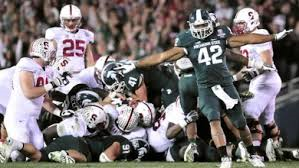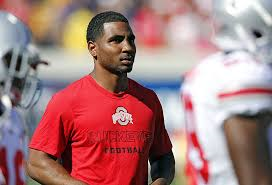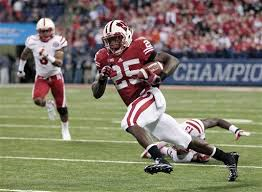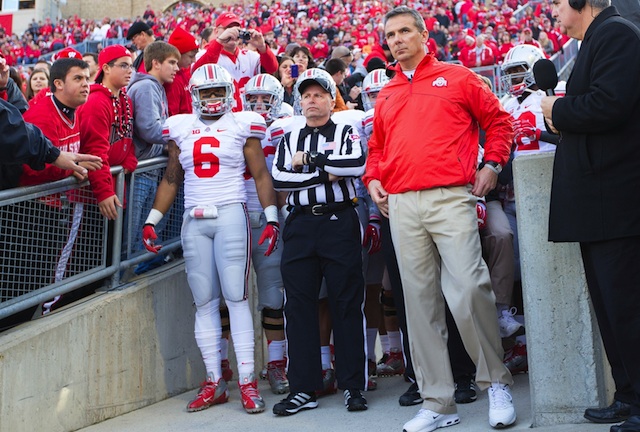The Big Ten is in a good place, and its future is the brightest it has been in some time. However, there are plenty of questions surrounding the league as it approaches the 2014 season.
Ohio State was a game away from playing Florida State for the national championship last year until it ran into Michigan State and the Spartans powerful defense. Both the Buckeyes and Spartans will be good again, and both schools are harboring Big Ten and national title aspirations. How will the Buckeyes fare after losing quarterback Braxton Miller for the season? Will the hype get the best of Michigan State?
Two new teams join the league this year: Rutgers from the American Athletic Conference and Maryland from the Atlantic Coast Conference. How will the newcomers to the Big Ten, Maryland and Rutgers, fare in their first season in the league? The addition of those two schools was much-derided, so both schools have a lot to prove.
Can Michigan rebound after a disappointing 2013? Will a team like Iowa or Wisconsin break through and take down one of the big two?
What will Penn State look like with James Franklin in charge?
2013 Year in Review

Michigan State celebrates a 4th down stop that sealed its Rose Bowl victory (Gary A. Vasquez / USA TODAY Sports)
The Big Ten’s 2013 season was a mix of disappointment and excitement as the conference’s premier names failed to live up to expectations while those with lesser pedigrees greatly exceeded them.
Ohio State was pegged as a national title contender before the season began, and the Buckeyes looked the part until a shocking 34-24 defeat at the hands of Michigan State in the Big Ten title game derailed those hopes. The Buckeyes then fell to Clemson 40-35 in the Orange Bowl.
Normally, a 12-2 season and BCS bowl game appearance would be a cause for celebration, but not for a school who had its sights set on a national championships, and especially not for a school that suffered numerous high-profile losses in big games. Repeatedly losing to the SEC is bad enough, but a marquee Big Ten program losing to an ACC team that didn’t even win its division? That’s bad for the ego.
Luckily, Michigan State was there to carry the standard for the conference. The Spartans suffocated Pac 12 champion Stanford, out-muscling a Cardinal program known for its toughness and sealing the win with a fourth down stop where Stanford’s vaunted power run game was absolutely stuffed.
The win allowed the Spartans to finish 13-1 and #3 in the country, and with Connor Cook and a ferocious defense, the Spartans have set their sights even higher this year.
The Spartans’ in-state rivals, the Michigan Wolverines, did not fare so well. Plagued by a porous offensive line, Michigan struggled on offense and stumbled to a 7-5 finish.
Nebraska can commiserate, as Bo Pelini’s squad lost four games for the sixth-straight year. Consistency is nice, but not in that regard, especially for a school with such a rich history. Much like Ohio State, Nebraska fans expect more.
Perhaps the most disappointing team was Northwestern. Coming off a ten-win season in 2012 and returning an experienced squad, the Wildcats began the year ranked in the top 25 and considered a potential dark horse. A promising 4-0 start was promptly followed by seven-consecutive losses. On the bright side, they were one win better than in-state rival Illinois.
Every disappointing team can at least take solace in the fact they weren’t Purdue, though. The Boilermakers were dreadful, finishing the year 1-11. Purdue went winless in conference, and its only win came against Indiana State.
All was not gloomy in the Big Ten, however.
Wisconsin went 9-4 in its first year under Gary Andersen and nearly upset Ohio State. Throw in a weird, questionable loss to Arizona State, and Wisconsin could very well have been 11-0 heading into its regular season finale. Granted the Badgers lost their final two games, but regardless, Year 1 in the Gary Andersen Era was a resounding success.
Iowa bounced back after several subpar seasons and won eight games, nearly taking down LSU in its bowl game to end the season.
Minnesota continued to improve under Jerry Kill, going 8-5 and even having a shot, albeit incredibly small, at earning a berth in the Big Ten championship game.
Bill O’Brien did a helluva job at Penn State. Despite crippling sanctions and the abhorrent Jerry Sandusky crimes and cover up, O’Brien managed to keep the Nittany Lions from imploding. Penn State wasn’t bowl-eligible, but the team still managed to go 7-5 and upset Wisconsin, a rather commendable achievement. O’Brien parlayed that success into the head coaching job with the NFL’s Houston Texans, but his replacement is no stranger to working with less than a full deck. James Franklin took Vanderbilt to unprecedented success in the rugged SEC, so he is used to overcoming obstacles.
Looking Ahead to 2014

Ohio State QB Braxton Miller is out for the season after re-injuring his shoulder (Kyle Robertson / Dispatch)
East Division: You Better Come Ready to Play
Encore! Encore!
Michigan State’s 2013 season was special. The Spartans knocked off previously-undefeated Ohio State, won the Big Ten, defeated Stanford in the Rose Bowl, and finished the season 13-1 and ranked third in the polls. How do they top that?
Michigan State’s defense was probably the toughest in the nation last year, and while it won’t be as dominant this season, it will still be good. The unit loses a lot of talent such as cornerback Darqueze Dennard and linebacker Max Bullough, but there are plenty of talented, experienced players waiting in the wings. The defense will drop in quality, but not by much.
Even if the defense isn’t quite as formidable, it won’t have to be thanks to a much-improved offense that got drastically better as the season progressed. Quarterback Connor Cook had the light bulb go off and finished the season on a tear, throwing for over 300 yards with three touchdowns against Ohio State and another 332 yards and two scores against Stanford. Most of the receivers return, as does running back Jeremy Langford, who rushed for nearly 1,500 yards and 18 touchdowns.
An early season game against Oregon in Eugene will provide a stiff test for the Spartans, but even if they lose that game, they will still have the inside track in the Big Ten. Nebraska, Michigan, and Ohio State all come to East Lansing, and when you add in the loss of Braxton Miller, the Spartans have to be considered the favorite in the East.
Major Questions at Ohio State
Coming into the season, hopes were high for Ohio State. The Buckeyes are 24-2 under Urban Meyer–although they are currently on a two-game losing streak–and were one game away from playing for the national title last year. Braxton Miller was a Heisman candidate, and Meyer has been recruiting like crazy.
Then Braxton Miller was lost for the season after re-injuring his shoulder.
Last year, Ohio State had the luxury of a capable backup in Kenny Guiton. They don’t have that this year. Untested J.T Barrett gets first crack at replacing Miller, and he won’t have the luxury of Carlos Hyde or Jordan Hall to hand the ball off to as both are gone. As if losing the top two rushers from last year wasn’t enough, the Buckeyes also have to replace last year’s top receiver and four offensive linemen.
Granted, the replacements are all blue-chip recruits, but they are inexperienced.
The defense struggled in 2013, too, and now it has to replace its best player, linebacker Ryan Shazier. Like the offense, there is plenty of potential, but it has yet to prove itself.
The Buckeyes are certainly the most talented team in the conference, but with the loss of Miller, the struggles on defense, and the lack of experience on offense, they’ll be the underdog against Michigan State.
What to Expect from the Wolverines?
Michigan was done in last year by horrid offensive line play. If the Wolverines weren’t getting big plays, they weren’t getting anything. Quarterback Devin Gardner pretty much had to carry the load–he was the team’s leading rusher–and he wore down under the constant pounding. Doug Nussmeier was brought in from Alabama to revamp the offense. Gardner returns, but starting tailback Fitzgerald Toussaint and star receiver Jeremy Gallon are both gone, as is top offensive tackle Taylor Lewan and fellow tackle Michael Schofield. Needless to say, that’s a concern.
On defense, Michigan was solid if unspectacular. This was a young unit that wasn’t good enough to carry the offense, but the bright side is that it returns a wealth of experience. It should be pretty good this season.
If the offense can gain some form of competency, a solid defense combined with a relatively easy schedule means the Wolverines should bounce back. They likely won’t contend for a conference championship, but eight or nine wins are a real possibility.
Welcome to the Neighborhood
As injuries mounted the past few years, Maryland was forced to play a host of players before they were fully ready. While it stunk at the time, it did set the stage for Maryland’s entrance into the Big Ten. All those youngsters now have a wealth of experience, and if Maryland can avoid the injury bug, it should make some noise in its new home.
With dual-threat quarterback C.J. Brown, running back Brandon Ross, and star receivers Stefon Diggs and Deon Long, there is a lot to like about Maryland’s offense. The Terrapins should have a pretty good defense, too. The front seven returns a lot of experience, and a secondary that was a weakness last year due to inexperience and injury ought to be much improved.
The schedule is pretty tough, but Maryland might just be good enough to handle it.
Baylor Lite?
Indiana has long been a doormat in the Big Ten, but there are signs that is changing. Coach Kevin Long has built one of the most powerful and explosive offenses in the country. Nat Sudfeld and Tre Roberson combined to throw for 3,650 yards, 36 touchdowns, and only 13 interceptions. The Hoosiers have to replace significant production at wide receiver, but running back Tevin Coleman is a true game-changer.
The problem, however, is the defense. The Hoosiers were atrocious on that side of the ball last year. Indiana was undefeated when allowing fewer than 41 points; the Hoosiers were 5-7 on the season. New coordinator Brian Knorr is installing a 3-4, and if he can get Indiana’s defense to match the solid unit he had at Wake Forest, the Hoosiers could win a lot of games and will almost certainly go bowling.
Light at the End of the Tunnel
It’s easy to see why there is so much optimism surrounding Penn State despite crippling sanctions, the loss of its head coach, and the aftermath of the horrific Sandusky scandal. The Nittany Lions exceeded expectations and not only survived on the field, they went 15-9 over the past two seasons. New coach James Franklin won at Vanderbilt–no easy task–and he inherits a franchise quarterback to build around in sophomore Christian Hackenberg. Penn State must rebuild the offensive line and find replacements for two-of-its-top-three wideouts, but the running game should be solid.
Penn State was stout against the run but had a tendency to give up big plays in the passing game. The front seven returns a wealth of experience, and the secondary has plenty of potential. It must improve its consistency to take the next step.
The schedule is quite favorable as they start the year off with a Central Florida team that is rebuilding and then get both Ohio State and Michigan State at home. Eight to ten wins is not out of the question at all, which would be a remarkable achievement considering how low the program was just a short time ago. Penn State isn’t eligible for the postseason this year, but with all the pieces Franklin is assembling, the rest of the country better watch out for the Nittany Lions once the ban is gone. They will be a force to be reckoned with.
Will Rutgers Prove It’s Worthy?
Few teams in the country will be facing more scrutiny than Rutgers after the Big Ten’s questionable decision to invite both Maryland and the Scarlet Knights to join the conference. Rutgers hasn’t done anything on the field to merit the invitation, and the claim that the school will provide the conference with exposure in the New York TV market is dubious at best.
If Rutgers struggles on the field, then that decision will look even more baffling than before. The Scarlet Knights have some intriguing pieces, but they need to figure out how to fit them all together effectively. Former Maryland head coach Ralph Friedgen was brought in to straighten out the offense. He has an explosive running back in Paul James and plenty of receivers with upside such as Tyler Kroft and Leonte Carroo. However, Friedgen will have to figure out how to get senior quarterback Gary Nova to become more consistent.
The defense was plagued with a propensity to give up big plays. This is a young unit that is brimming with potential but lacking experience and consistency. How quickly that potential can be translated into production will go a long way towards determining how successful Rutgers will be in its inaugural Big Ten season.
The schedule is daunting for such an inconsistent team, and while a bowl is a possibility, it’s also quite easy to see Rutgers losing 7-9 games.
West Division: Wisconsin and a Bunch of Unknown Quantities
Badgers Keep on Rollin’
With the balance of power squarely in the East–both Michigan State and Ohio State are in that division–Wisconsin is the clear favorite in the West.
Once again, Wisconsin will run all over the opposition. Junior Melvin Gordon averaged 7.8 yards per carry while racking up 1,609 yards and 12 touchdowns on the ground. His backup, sophomore Corey Clement, averaged 8.2 yards per carry and contributed another 547 yards and 7 touchdowns.
The passing game is a question mark, though. Quarterback Joel Stave returns, but he wasn’t great a year ago and loses his top four receivers.
Another question mark is the defense. Wisconsin suffered heavy losses in its front seven, and while there are plenty of highly-recruited players, they aren’t proven. The secondary went through growing pains last year, however, and should benefit from that year of experience.
The Badgers are about the only sure thing in the West, and with Ohio State and Michigan in the East, the road to the Big Ten championship game looks pretty clear. Wisconsin should have another great season and make it to the title game.
Clockwork Red
It’s funny, Nebraska fired Frank Solich because his teams had declined from elite to good. After the disastrous Bill Callahan hiring, the school hired Bo Pelini, whose teams are good but still not elite. Under Pelini, the Cornhuskers have lost four games in six-consecutive seasons, a rather remarkable feat when you think about it.
The Cornhuskers will be hard-pressed to keep the streak alive in 2014, and that’s not a good thing. An offense that wasn’t great to begin with has an inconsistent quarterback who will be working behind a rebuilt offensive line. Quarterback Tommy Armstrong, Jr. completed less than 52 percent of his passes and threw nearly as many interceptions as touchdowns. The receiving corps is young and untested with the exception of senior Kenny Bell. Bell, however, is coming off a subpar junior season. At least Nebraska has running back Ameer Abdullah, one of the best backs in the country. The senior rushed for just under 1,700 yards with 9 touchdowns last year.
Defensive end Randy Gregory is a quarterback nightmare, and the linebacking corps is good. The secondary loses a pair of playmaking corners but has replacements who have seen game action. Unfortunately for the Cornhuskers, depth is an issue.
The biggest issue for Nebraska, though, is the schedule. All of the Cornhuskers’ tough games are on the road. They have to go to Northwestern, Michigan State, Wisconsin, and Iowa. Throw in a non-conference road game against Fresno State, a place where many a power conference team has met an unfortunate end, and Nebraska is looking at four losses right there. They’ll have to run the table at home and/or pull off a couple of road upsets to avoid yet another four-loss campaign or worse.
Welcome Back, Iowa
Iowa seemingly came out of nowhere to win eight games last year, reminding everyone that yes, Kirk Ferentz is a pretty good coach. The Hawkeyes aren’t spectacular, they’re just effective. They lack big play ability on offense and are weak at receiver, but the offensive line is experienced, and returning quarterback Jake Rudock has a group of solid running backs to give the ball. The defense was a strength a year ago, but while the line will be good, Iowa must replace all three starting linebackers as well as cornerback B.J. Lowery.
Iowa has the benefit of a generous schedule–to put it mildly–and should win 9-10 games. Look for the Hawkeyes to be Wisconsin’s primary challenger in the West division.
Steady Improvement
Under coach Jerry Kill, Minnesota won eight games for the first time in a decade and has steadily improved each season. The Golden Gophers lose star defensive tackle Ra’Shede Hageman but return six starters and should field one of the best secondaries in the conference. On offense, sophomore quarterback Mitch Leidner returns after starting towards the end of last season. The unit he leads isn’t that explosive, but it boasts a stable of solid running backs and plenty of young, talented receivers.
There is a lot to like about Minnesota, and the Golden Gophers have an excellent chance to keep improving. If they can pull off a few upsets-and they get Iowa and Ohio State at home in November–they could possibly reach double-digit wins. Then again, this very well could be a case of a team improving but not having that show up in its won-loss record. The Gophers end the season with four straight games against four of the conference’s best teams and very well could go 0-4 over that stretch. Still, that should be enough for Minnesota to go bowling.
Can the Wildcats Bounce Back?
Expectations were high for Northwestern a year ago. The Wildcats were coming off a 10-win season and returning plenty of experience. Things looked good when the Wildcats raced out to a 4-0 start and hung tough against Ohio State, but it was downhill from there. Northwestern promptly went on a seven-game losing streak. Throw in some offseason turmoil–former quarterback Kain Colter spearheaded an effort to form a college football player union and star running back Venric Mack was suspended two games before announcing his intention to transfer–and it’s safe to say Northwestern isn’t in a great place right now.
There is considerable reason for optimism, however.
The offense does return quite a bit of experience, but it needs to produce some big plays and will be even more hard-pressed to do so without Mack. Still, this is a solid unit with a deep, experienced offensive line and reliable backs and receivers.
The defense was fairly decent last year; it just fell apart at really inopportune times and had issues in pass coverage. The Wildcats should rush the passer pretty well and boast a good group of linebackers. The secondary, a weakness a year ago, should be improved as those young guys are now older and more experienced. Plus, it doesn’t hurt to have a safety like Ibraheim Campbell and his six interceptions.
The Wildcats will no doubt be better in 2014, but asking them to take down Wisconsin and vie for the western division crown is a bit too much to ask. Northwestern will return to a bowl game and could approach ten wins, but they’ll need some help to achieve beyond that.
For Mature Audiences Only, Viewer Discretion Advised
Illinois improved in Tim Beckman’s second season at the helm, as 4-8 is better than 2-10. A six-game losing streak in the middle of the season scuttled any chances of a bowl game, but hey, any time you double your win total, it’s a good thing.
Longtime-starter Nathan Scheelhaase is gone, so Illinois will need to break in a new quarterback. Oklahoma State transfer Wes Lunt gets first crack at the gig, and his job will be made easier by the presence of running back Josh Ferguson, a dual-threat back who rushed for nearly 800 yards and caught 50 passes for 520 yards.
A porous defense and daunting road schedule will be the Illini’s undoing, though. A bowl game isn’t out of the question, but everything needs to go Illinois’ way for that to happen. Four or five wins is more reasonable.
To say Purdue was awful in 2013 would be putting it mildly. “Dumpster fire” would be a more apt description. The Boilermakers went 1-11 with their lone win coming against FCS team in Indiana State that also finished 1-11, and even that game almost went the other way. Purdue won 20-14 and needed a late interception to seal the win.
The offense was dreadful, but the silver lining is that it was young. Nearly everyone returns, so in theory, they should be better. The defense was a little more reliable, but it lacked the ability to make big plays. Like the offense, the hope is that experience translates to improved performance.
There’s just no way to sugarcoat it: Purdue is a major rebuilding project, and there is a lot of work left to do. This is going to take awhile. Sorry Purdue fans.
East Division Champion
Michigan State
The only team in the division with the same balance and talent as the Spartans is Ohio State, and not only do the Buckeyes come to East Lansing, they won’t have Braxton Miller. Indiana appears to have the only offense capable of denting the Spartan defense, but there is no way the Hoosiers will be able to shut down the Spartan offense. Penn State is an intriguing opponent, but a young quarterback against Pat Narduzzi’s defense isn’t a fair fight.
West Division Champion
Wisconsin
This is an easy choice. The Badgers are the only consistent program in the division, and not only that, they’re really good. They are potent on both sides of the ball, and Melvin Gordon is one of the best players in the country. Yes, the Badgers have questions, but those questions are less significant than those facing their chief rivals.
Conference Champion
Michigan State
The Badgers are good, but Michigan State is better. They have the defense to shut down the Badgers’ powerful ground game, and Wisconsin isn’t adept enough at the pass to overcome that. Connor Cook proved in the Rose Bowl against Stanford he can succeed against a strong defense, and he’ll be able to make enough plays against Wisconsin.







